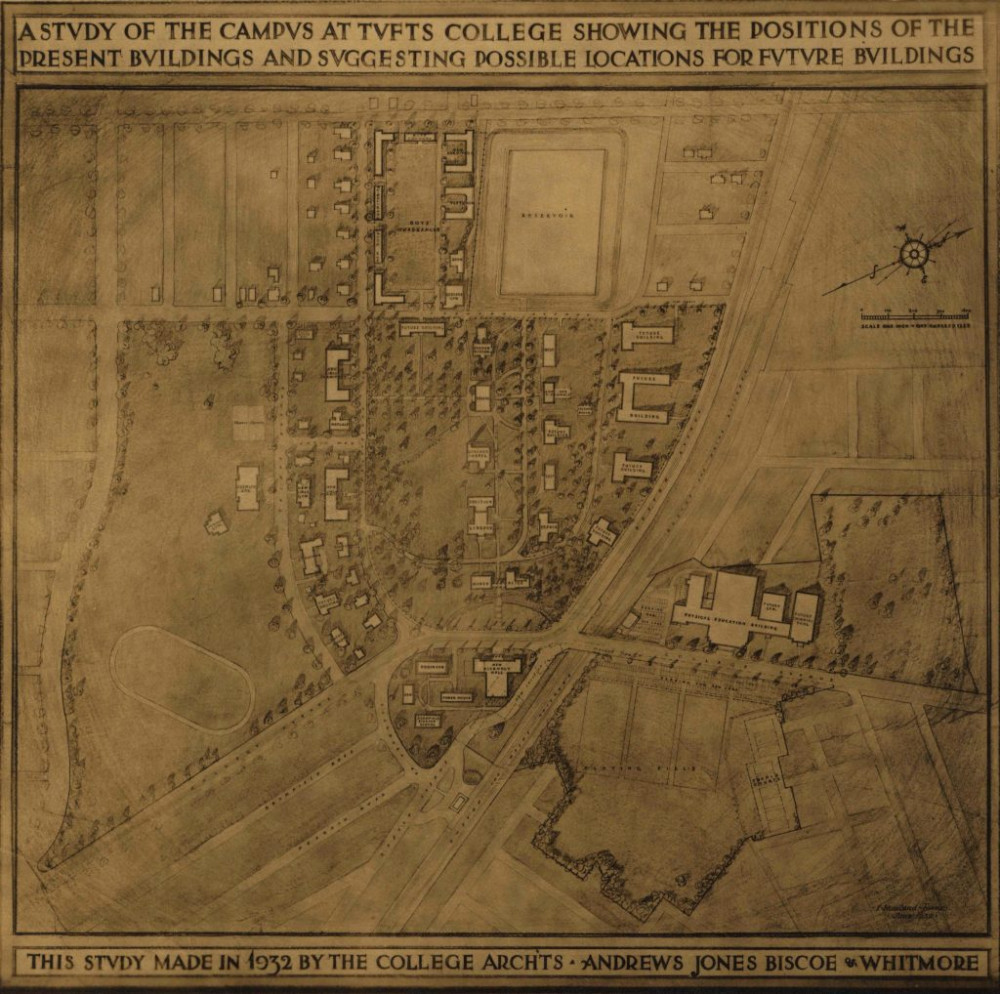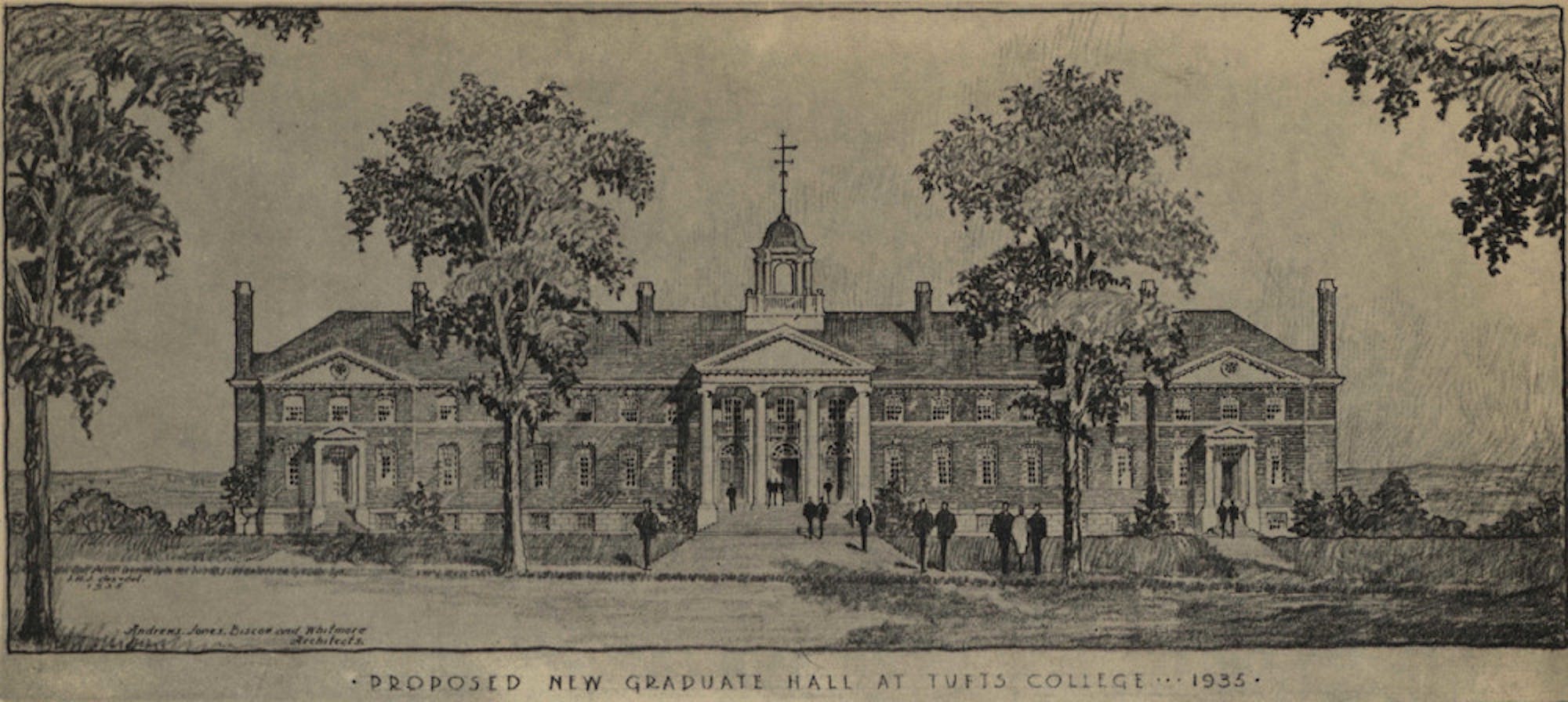In the 1930s, Tufts lacked many of the distinct features and buildings it has today. There was no residential quad, and downhill campus was a part of Jackson College. Uphill, there was the academic quad and some academic and residential buildings, along with an adjacent reservoir — known as the "Rez" — standing where the residential quad is now.
But then University President John Albert Cousens had a vision for architectural expansion that would build up Tufts to grow from a regional college into a national university.
In 1932, Cousens commissioned college architectural firm Andrews, Jones, Biscoe and Whitmore to make his ambitious architectural plan for Tufts a reality. Prior to Tufts, the firm had completed projects at numerous prominent colleges and universities, including Wellesley College, Harvard University and Pembroke College, the former women's college in Brown University.
"This plan addressed a liberal arts college just beginning to shift to a university with the onset of Fletcher," Tufts Director of Campus Planning Lois Stanley told the Daily in an email. As a part of his expansion plan, Cousens successfully established the Fletcher School of Law and Diplomacy in 1933.
According to the firm’s November 1932 report on the project, the firm was partly drawn to Tufts because of its "dignity and charm."
“The College and its unusual situation on the Hill, with its present arrangement of buildings and lawns and trees, is one of the most distinctive and beautiful college groups in the country, and nothing should ever be done to change the atmosphere it has at present," the report reads.
The plan targeted three areas for development. First, the firm called for the construction of a large building with an auditorium opposite the Memorial Steps that would seat 1,500 people.The first and second floors would house recital rooms, while the basement would have a cafeteria.
This building, adjacent to the already existing Robinson Hall, would also house the new engineering school. Across the street, the firm also predicted that one day the railroad tracks, which currently service the MBTA Commuter Rail, would be filled in and that the property would be used for parkland and as an athletic field.
The second area of the plan included a proposal for additional housing by developing the hill area between Boston Avenue and the Academic Quad. Buildings would front Boston Avenue at a height of three or four stories and extend up the hill, terminating on what is today North Hill Road at a height of one story. Additional paths would be laid out to facilitate access to the buildings from Boston Avenue.
Finally, the firm planned for a new residential quad on what is today Fletcher Field. The firm noted in its plan that separate housing for male and female students would be built and that the residential halls would be arranged to form an enclosed quadrangle. A line of trees would be present on the west end to balance the green space in what is currently the President's Lawn.Most of the buildings would have been built with red brick and would incorporate a white portico similar to what was seen in East Hall, which had already been built.
Another prominent feature of the plan was a graduate hall for the newly established Fletcher School. Along with housing several hundred more students, the buildings in the complex would be fitted with luxuries such as individual dining halls, lounges, billiard rooms, card rooms, bowling alleys and reception rooms for guests.
In addition to several other proposed buildings downhill, the firm eventually called for the demolition of Packard, Curtis and Barnum Halls, recommending their replacement with either the larger grandiose structures proposed or demolished to make way for street improvements or future construction plans.
Despite larger-scale plans, Tufts' finances were at this time were insufficient to fully realize the vision that Cousens and the architectural team had in mind. Accordingly, only four of the buildings from the proposed plan were eventually constructed from this initial plan because of the Great Depression:Gifford House, Braker Hall, Blakeley Hall and Stratton Hall.
“There is a lot of building square footage in this plan," Stanley said. "To build the full scheme would have cost many, many millions I’m sure, despite it being the Depression."
Stanley also noted that the plan differed from the current layout of the Medford/Somerville campus in the planners' preferences about campus atmosphere.
“The biggest difference I see is the development of housing, and the preservation of what we consider to be historic campus buildings [such as West and Curtis Halls,]" she said. "I like the proposal for housing that fronts Boston Avenue because our campus would benefit from a better street frontage there. I prefer the smallish scale of the buildings on the hill as it developed, preserving the intimacy and classic liberal arts campus style that the architects praise in the proposal.”
Later architects such as Arland Dirlam (A '26), who designed Bendetson Hall, Carmichael Hall and Jackson Gym, reference the 1930s designs of Stratton, Braker and Blakeley Halls in his 1950s and 1960s plans.
“Surprisingly, there are some aspects of the plan that have or will soon come to fruition – 'an engineering building' behind and next to Robinson [Hall], athletics fields across from the Cousens Gym and pedestrian safety improvements at the Boston Avenue/College Avenue intersection,” Stanley said.
A campus plan prepared in 2006 by William Rawn and Associates displays many of the features shown in the 1932 proposal, Stanley said.Today, Fletcher Field is identified by William Rawn and Associates, the architects of Sophia Gordon Hall, as one of dozens of "buildable sites" on campus, according to Stanley. However, she noted that there are no current plans to develop this plot of land.
Despite the fact that Tufts does not have a campus-wide plan at this time, Stanley noted that architects and planners in recent years have conceived a similar scheme proposed by the firm in the 1930s.
She added that today’s Science and Engineering Complex is highly reminiscent of the proposals set forth 80 years ago, concluding that the architecture of Tufts today is largely the result of Cousens and the firm of Andrews, Jones, Biscoe and Whitmore.
History on the Hill: Cousens and the incomplete 1930s campus plan






